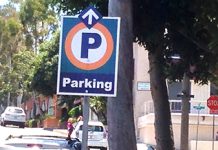After months of hearings, a draft of proposed new rules to resolve view disputes – a process raising fractious questions over community aesthetics as well as high-price home values — was submitted for review to staff last month and was posted Tuesday on the city’s web site.
Staff will meet next week with the city attorney to go over it and have tentatively set Sept. 3 as the date for review by the City Council, said Principal Planner Carolyn Martin.
With the aim of rewriting a view ordinance “with teeth,” Mayor Kelly Boyd convened a committee in January to draft such a measure. Seven well-attended public hearings have been held since.
By the fifth meeting, the committee had cobbled together a rough draft of an ordinance and made subsequent revisions at their next two meetings based on public comments. On June 25, committee chair Larry Nokes asked the members of three interest groups to present their positions to the public: a group opposing the ordinance led by John Thomas, Liza Stewart, Ginger Osborne and Charlotte Maserik; Citizens for View Preservation and Restoration, pushing for an even stronger ordinance; and the Beautification Council, which argues for a moderate approach and the need to better educate the public.
“That was very useful,” said Nokes, who said committee members took all of the public input to heart when they got down to writing the final revision of the draft.
The proposal defines a view, reasonable interference to a view, and what steps can be taken to resolve that interference. “It’s our best effort,” said Nokes.
In its current form, the draft sets forth its purpose “to establish a process for property owners to restore a view…which has been significantly obstructed by vegetation, while striking an equitable balance between the reasonable use of one’s property including the maintenance of privacy and the protection from loss of views.” It also includes the caveat that it “is not intended to encourage or result in the substantial denuding of any property of its vegetation by overzealous application of provisions of [the ordinance].”
The document shows that committee members made decisions on some of the sticking points debated in the public hearings, such as who pays and the distance of the view obstruction. Others, such as the date the view was established and who will make up the arbitrating committee, the committee left to the council’s discretion or that of future arbitrating body.
The proposal establishes that “both views and vegetation contribute to the aesthetic and economic value of properties within the city, and enhance the quality of life of its residents.” It also establishes that applicants have the right to restore “significant views” that have been “unreasonably” obstructed by vegetation within 500 feet of the applicant’s property, and it requires mediation, for a fee of $1,000 paid by the applicant. Only if the mediation fails, can the applicant submit a formal view restoration application to the city, for a fee to be determined by the council. In the event the applicant’s claim succeeds, the applicant will bear the cost of complying the first time.
The proposal also calls for an appointed View Preservation and Restoration Committee to determine of validity of an applicant’s claim of obstruction. The ordinance lays out “unweighted guiding principles” to be considered by the committee, including, among others, the quality of the view being obstructed, whether it existed at the time of purchase of the property, when the offending vegetation was planted and whether the property owner has evidence of the view prior to obstruction.
During public hearings, some residents had expressed the desire to have an ironclad date set for establishing the view while others wanted no date at all to be considered.
City staff, based on their review and discussions with the attorney, may ask for revisions prior to submitting it to the City Council for review, Martin said.
Also this week the Citizens for View Preservation and Restoration, advocates for a strong ordinance, released the results of an online poll, taken in July. About 85 people completed the survey. Most participants claimed to be full-time residents who own their home, and only five percent of survey respondents said their views are unobstructed. More than half claimed that the obstruction did not exist when they purchased their home, with years of ownership ranging from one to 56.
Asked about fees to apply for a view obstruction claim, more than half of survey takers selected less than $1,000, and almost 30 percent said no fee should be charged.




